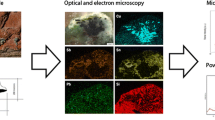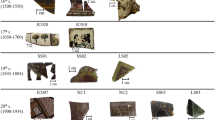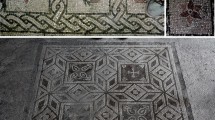Abstract
The “Great View of Lisbon” is one of the most remarkable blue-and-white Portuguese tile panels, which depicts the city before the tragic earthquake of 1755. This panel presents visible colored alteration in the glaze of tiles both from the exhibition and the depository of the Museu Nacional do Azulejo (Portugal). This work is a contribution to identify the origin of green stains in the glaze by using microbiological techniques, scanning electron microscopy with back-scattered electron imaging (SEM-BSE), Raman spectroscopy, and proton-induced X-ray emission (PIXE). The microbiological assays showed that the filamentous fungi were detected only at a frequency <10 % of the microbiota of tiles surface, and the microbial entities from the green stains cultures were identified as Aspergillus fumigatus by molecular biology techniques. However, no microorganisms or other biological elements were found by SEM-BSE in the green stains. Raman spectroscopy and PIXE results showed that the green stains appear to be related with the presence of chromium atoms in the outer part of the glaze. Eskolaite, a “green pigment” used before 1850 AD was clearly identified by Raman spectroscopy in the darker green stains. Nevertheless, no chromium oxide signatures were identified in the lighter green stains by Raman spectroscopy.












Similar content being viewed by others
References
Carvalho AP, Vaz MF, Samora MJ, Pires J (2006) Characterization of ceramic pastes of Portuguese ancient tiles. Mater Sci Forum 514–516:1648–1652
Dias MI, Prudêncio MI, Pinto De Matos MA, Luisa Rodrigues A (2013) Tracing the origin of blue and white Chinese Porcelain ordered for the Portuguese market during the Ming dynasty using INAA. J Archaeol Sci 40:3046–3057
Larbi JA (2004) Microscopy applied to the diagnosis of the deterioration of brick masonry. Constr Build Mater 18:299–307
Casasola R, Ma Rincón J, Romero M (2012) Glass–ceramic glazes for ceramic tiles: a review. J Mater Sci 47:553–582
Borges C, Caetano C, Costa Pessoa J, Figueiredo MO, Lourenço A, Gomes MM, Silva TP, Veiga JP (1997) Monitoring the removal of soluble salts from ancient tiles by ion chromatography. J Chromatogr A 770:195–201
Oliveira MM, Sanjad TBC, Bastos CJP (2001) Biological degradation of glazed ceramic tiles. In: Lourenço PB, Roca P (eds) Historical constructions. University of Minho, Guimarães, pp 337–342
Giacomucci L, Bertoncello R, Salvadori O, Martini I, Favaro M, Villa F, Sorlini C, Cappitelli F (2011) Microbial deterioration of artistic tiles from the façade of the Grande Albergo Ausonia & Hungaria (Venice, Italy). Microb Ecol 62:287–298
Coutinho ML, Miller AZ, Gutierrez-Patricio S, Hernandez-Marine M, Gomez-Bolea A, Rogerio-Candelera MA, Philips AJL, Jurado V, Saiz-Jimenez C, Macedo MF (2013) Microbial communities on deteriorated artistic tiles from Pena National Palace (Sintra, Portugal). Int Biodeterior Biodegrad 84:322–332
Prudêncio MI, Stanojev Pereira MA, Marques JG, Dias MI, Esteves L, Burbidge CI, Trindade MJ, Albuquerque MB (2012) Neutron tomography for the assessment of consolidant impregnation efficiency in portuguese glazed tiles (16th and 18th centuries). J Archaeol Sci 39:964–969
Nunes I, Mesquita N, Cabo Verde S, Carolino MM, Portugal A, Botelho ML (2013) Bioburden assessment and gamma radiation inactivation patterns in parchment documents. Radiat Phys Chem 88:82–89
Simões JMS (1970) http://www.flickr.com/photos/biblarte/5424965139/in/photostream/. Accessed 6 April 2015
Silva TP, Figueiredo MO, Barreiros MA, Prudêncio MI (2013) Decorative 18th century blue-and-white Portuguese tile panels: a type-case of environmental degradation. J Mater. doi:10.1155/2013/972018
Silva TP, Figueiredo MO, Prudêncio MI (2013) Ascertaining the degradation state of ceramic tiles: a preliminary non-destructive step in view of conservation treatments. Appl Clay Sci 82:101–105
Silva TP, Figueiredo MO, Barreiros MA, Prudêncio MI (2014) Diagnosis of pathologies in ancient (seventeenth-eighteenth centuries) decorative blue-and-white ceramic tiles: Green stains in the glazes of a panel depicting Lisbon prior to the 1755 earthquake. Stud Conserv 59(2):63–68
Simões JMS (1961) Iconografia olissiponense em azulejos. Olisipo 95:115–1342
Vieira da Silva A (1932) Museu Nacional de Arte Antiga, Armas e Troféus I:6–24.
Meco J (1994) Azulejos com Iconografia de Lisbon—Breve revisão. Olisipo II:1
Pereira J C-B, Gomes MM, Tavares DS (1992) The treatment of ancient Portuguese Tiles, Conservation of the Iberian and Latin American Cultural Heritage. Proceedings of the IIC Madrid Congress, pp 112–115.
Holt, JG, Kreig NR, Sneath PHA, Staley JT, Williams ST (1994) Bergey’s manual of determinative bacteriology, 9th ed. Williams and Wilkins Editors, Baltimore
Mesquita N, Portugal A, Videira S, Rodríguez-Echeverría S, Bandeira AML, Santos MJA, Freitas H (2009) Fungal diversity in ancient documents. A case study on the archive of the University of Coimbra. Int Biodeterior Biodegrad 63:626–629
Wierzchos J, Ascaso C (1996) Morphological and chemical features of bioweathered granitic biotite induced by lichen activity. Clay Clay Miner 44:652–657
Wierzchos J, Ascaso C (1994) Application of back-scattered electron imaging to the study of the lichen rock interface. J Microsc 175:54–59
Wierzchos J, Ascaso C (1998) Mineralogical transformation of bioweathered granitic biotite, studied by HRTEM: evidence for a new pathway in lichen activity. Clay Clay Miner 46:446–452
Guilherme A, Hodoroaba V-D, Benemann S, Coroado J, Carvalho ML (2014) Morphological and compositional features of blue and yellow pigments used in Portuguese glazed ceramics by SEM/EDX—unravelling manufacturing differences. J Anal At Spectrom 29:51–57
Villar SEJ, Edwards HGM (2006) Raman spectroscopy in astrobiology. Anal Bioanal Chem 384:100–113
Alves LC, Breese MBH, Alves E, Paúl A, da Silva MR, da Silva MF, Soares JC (2000) Micron-scale analysis of SiC/SiCf composites using the new Lisbon nuclear microprobe. Nucl Instrum Methods Phys Res Sect B 161–163:334–338
Corregidor V, Alves LC, Barradas NP, Reis MA, Marques MT, Ribeiro JA (2011) Characterization of mercury gilding art objects by external proton beam. Nucl Instrum Methods B 269:3049–3053
Corregidor V, Alves LC, Rodrigues PA, Vilarigues M, Silva RC (2011) The external ion beam facility in Portugal for studying cultural heritage. E-Conserv Mag 22:40–52
Pedi N, Conceição E, Fernandes MJ, Massa D, Nogueira E, Pérside R, Arcoverde JH, Lemos S, Marsden A, Neves R. (2009) Fungos isolados em azulejos do convento de Santo António, Recife, Pernambuco. In: JEPEX 2009—IX Jornada de Ensino, Pesquisa e Extensão da UFRPE, pp 550–551
Latgé JP (1999) Aspergillus fumigatus and Aspergillosis. Clin Microbiol Rev 12:310–350
Sharma K, Lanjewar S (2010) Biodeterioration of ancient monument (Devarbija) of Chhattisgarh by fungi. J Phytol 2:47–49
De la Rosa-García SC, Ortega-Morales O, Gaylarde CC, Beltrán-García M, Quintana-Owen P, Reyes-Estebanez M (2011) Influence of fungi in the weathering of limestone of Mayan monuments. Revista Mexicana de Micología 33:43–51
Palmer RJ Jr, Hirsch P (1991) Photosynthesis-based microbial communities on two churches in Northern Germany: weathering of granite and glazed brick. Geomicrobiol J 9:103–118
Langfelder K, Philippe B, Jahn B, Latge JP, Brakhage AA (2001) Differential expression of the Aspergillus fumigatus pksP gene detected in vitro and in vivo with green fluorescent protein. Infect Immun 69:6411–6418
Ascaso C, Wierzchos J, Souza-Egipsy V, de los Ríos A, Rodrigues JD (2002) In situ evaluation of the biodeteriorating action of microorganisms and the effects of biocides on carbonate rock of the Jeronimos Monastery (Lisbon). Int Biodeterior Biodegrad 49:1–12
Amann RI, Ludwig W, Schleifer KH (1995) Phylogenetic identification and in situ detection of individual microbial cells without cultivation. Microbiol Rev 59:143–169
Bouchard M, Smith DC (2003) Catalogue of 45 reference Raman spectra of minerals concerning research in art history or archeology, especially on corroded metals and coloured glass. Spectrochim Acta Mol Biomol 59:2247–2266
http://www.chem.ucl.ac.uk/resources/raman/. Accessed December 2014
Colomban P, Sagon G, Faurel X (2001) Differentiation of antique ceramics from the Raman spectra of their coloured glazes and paintings. J Raman Spectrosc 32:351–360
Acknowledgements
Work developed within the Project RADIART (PTDC/HIS-HEC/101756/2008) financed by the Portuguese Foundation for Science and Technology (FCT/MCTES). JW and CA are thankful for the support by Grant CGL2010-16004 from the Spanish Ministry of Science and Innovation. S. Cabo Verde and V. Corregidor acknowledge the program Ciência 2008 of FCT, Portugal. C2TN/IST authors gratefully acknowledge the FCT (the Portuguese Science and Technology Foundation) support through the UID/Multi/04349/2013 project.
Author information
Authors and Affiliations
Corresponding author
Rights and permissions
About this article
Cite this article
Cabo Verde, S., Silva, T., Corregidor, V. et al. Microbiological and compositional features of green stains in the glaze of the Portuguese “Great View of Lisbon” tile panel. J Mater Sci 50, 6656–6667 (2015). https://doi.org/10.1007/s10853-015-9217-4
Received:
Accepted:
Published:
Issue Date:
DOI: https://doi.org/10.1007/s10853-015-9217-4




